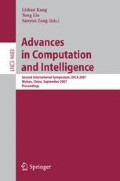Abstract
The World Wide Web’s vast growth contains a great variety and quantity of on-line information. People need to have the computing systems with the ability to process those documents to simplify the text information. One type of appropriate processing is called Information Extraction (IE) technology. Information extraction can be regarded as one kind of classification problems and one of the main methods to deal with the problem is pattern rule induction. Due to the uncertainty during the induction of pattern rules from natural language texts, in this paper we introduce a Fuzzy pattern Rule Induction System (FRIS) to obtain fuzzy pattern rules for information extraction from semi-structured webpages and free texts.
Access this chapter
Tax calculation will be finalised at checkout
Purchases are for personal use only
Preview
Unable to display preview. Download preview PDF.
References
Cardie, C.: Empirical Methods in Information Extraction. AI Magazine 18(4), 65–79 (1997)
Califf, M.E.: Relational Learning Techniques for Natural Language Information Extraction. Ph.D. Thesis, University of Texas at Austin (1998)
Califf, M.E., Mooney, R.J.: Relational Learning of Pattern-Match Rules for Information Extraction. In: Proceedings of the ACL Workshop on Natural Language Learning, pp. 9–15 (1997)
Soderland, S.: Learning Information Extraction Rules for Semi-structured and Free Text. Machine Learning 34, 233–272 (1999)
Muggleton, S.: Inverse Entailment and Progol. New Generation Computing. Special issue on Inductive Logic Programming, 245–286 (1995)
Zelle, J.M., Mooney, R.J., Konvisser, J.B.: Combining Top-down and Bottom-up Methods in Inductive Logic Programming. In: Proceedings of the 11th International Conference on Machine Learning, pp. 343–351 (1994)
Muslea, I.: Extracting Patterns for Information Extraction Tasks: A Survey. In: AAAI-Workshop on information extraction (1999)
Riloff, E.M.: Automatically Constructing a Dictionary for Information Extraction Tasks. In: Proceedings of the 11th National Conference on Artificial Intelligence, pp. 811–816 (1993)
Soderland, S., Fisher, D., Aseltine, J., Lehnert, W.: Crystal: Inducing a Conceptual Dictionary. In: Proceedings of the 14th International Joint Conference on Artificial Intelligence, pp. 1314–1319 (1995)
Ciravegna, F.: Adaptive Information Extraction from Text by Rule Induction and Generalization. In: Proceedings of the 17th International Joint Conference on Artificial Intelligence (2001)
Chieu, H.L., Ng, H.T.: Named Entity Recognition: A Maximum Entropy Approach Using Global Information. In: Proceedings of 19th International Conference on Computational Linguistics, pp. 190–196 (2002)
Chua, T.S., Liu, J.: Learning Pattern Rules for Chinese Named Entity Extraction. In: Proceedings of the 18th National Conference on Artificial Intelligence, pp. 411–418 (2002)
Sankoff, D., Kruskal, J.: Time Wraps, String Edits, and Macromolecules, the Theory and Practice of Sequence Comparison. CSLI Publications, Stanford, CA (1999)
Proceedings of the Fourth Message Understanding Conference, Morgan Kaufmann Publishers (1992)
Chieu, H.L., Ng, H.T., Lee, Y.K.: Closing the Gap: Learning-Based Information Extraction Rivaling Knowledge-Engineering Methods. In: Proceedings of the 41st Annual Meeting of the Association for Computational Linguistics, pp. 216–223 (2003)
Chieu, H.L., Ng, H.T.: A Maximum Entropy Approach to Information Extraction from Semi-Structured and Free Text. In: Proceedings of the 18th National Conference on Artificial Intelligence, pp. 786–791 (2002)
Author information
Authors and Affiliations
Editor information
Rights and permissions
Copyright information
© 2007 Springer-Verlag Berlin Heidelberg
About this paper
Cite this paper
Xiao, J. (2007). Fuzzy Pattern Rule Induction for Information Extraction. In: Kang, L., Liu, Y., Zeng, S. (eds) Advances in Computation and Intelligence. ISICA 2007. Lecture Notes in Computer Science, vol 4683. Springer, Berlin, Heidelberg. https://doi.org/10.1007/978-3-540-74581-5_70
Download citation
DOI: https://doi.org/10.1007/978-3-540-74581-5_70
Publisher Name: Springer, Berlin, Heidelberg
Print ISBN: 978-3-540-74580-8
Online ISBN: 978-3-540-74581-5
eBook Packages: Computer ScienceComputer Science (R0)

